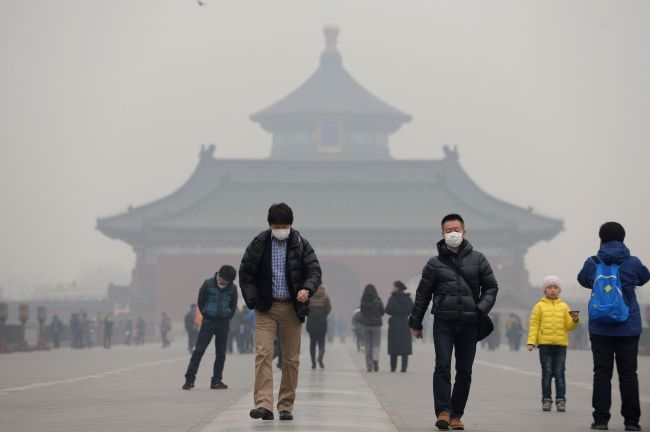 |
This picture shows visitors wearing masks at the Temple of Heaven in haze-covered Beijing. (AFP-Yonhap) |
Chinese President Xi Jinping said pollution was Beijing’s biggest challenge as thick smog blanketing northern China cleared after seven straight days at hazardous levels.
Xi called preventing air pollution the “most prominent” problem Beijing faces, according to a report on China National Radio, as pollution dropped to “very unhealthy” levels from “hazardous,” according to a U.S. Embassy monitor.
The lingering pollution in China’s capital renewed questions about the government’s determination to address environmental damage that’s accompanied three decades of double-digit economic growth. The issue will probably feature in discussions as Chinese leaders gather for an annual meeting of the national legislature next week.
The concentration of PM2.5, the small particles that pose the greatest risk to human health, dropped to 11 at 7 a.m. from above 500, or “beyond index,” yesterday, according to the U.S. Embassy pollution monitor. That’s less than half the World Health Organization’s recommended day-long exposure limit of 25, and the last time PM2.5 had dropped below 150 in Beijing was Feb. 19.
Xi said on Feb. 25 that Beijing’s main task is cutting levels of PM2.5, and the city should ease its reliance on coal and reduce vehicle use, China Central Television reported yesterday. Also on Feb. 25, Xi visited a busy shopping street in Beijing, drawing comments from Chinese Internet users for not wearing a face mask despite the smog.
“Breathe together, share a common fate,” Beijing News wrote on its microblog when it posted photos of Xi not ear.
In efforts to address the smog, China’s National Energy Administration will push for upgrading fuel products, reducing coal usage and strengthening coal quality management to control pollution, according to a statement on the administration’s website yesterday.
It also plans to boost the use of natural gas this year and speed up solar, wind and geothermal use to diversify away from coal, according to the statement.
“Being in Shanghai, the best thing I can say is thank God I’m not in Beijing,” said J. Paul Beddie, a Shanghai-based vice president at management consulting firm Genpact Asia Pacific. “Fifteen to twenty years from now you’ll probably see a spike in various diseases and health care issues you’ll tie back to this period in Chinese development. All great economies have gone through it.”
Smog here is now at an “unbearable stage,” the government’s top climate-change adviser, Li Junfeng, said Feb. 23. That statement followed a Shanghai Academy of Social Sciences report that said Beijing, was “barely suitable” for living.
The conditions in Beijing were similar to those the city saw before the meeting of the legislature last year, when concentrations of PM2.5 rose to 469, according to the Beijing government.
“It is very significant what we are seeing in Beijing at the moment,” World Travel & Tourism Council President David Scowsill said in an interview with Bloomberg Television. “Because it’s live and it’s out there and it’s on the front page of the news, if that stays there and they don’t manage the situation, then in a period of three to four weeks they will see a lot of cancellations, particularly people from Asia.”
In a bid to fight Beijing’s pollution, 147 industrial companies have cut or suspended production, the Xinhua News Agency reported, citing the Beijing Municipal Economic and Information Commission. In Liaoning and Shandong provinces, visibility fell to less than 50 meters and expressways were closed, Xinhua said. (Bloomberg)








